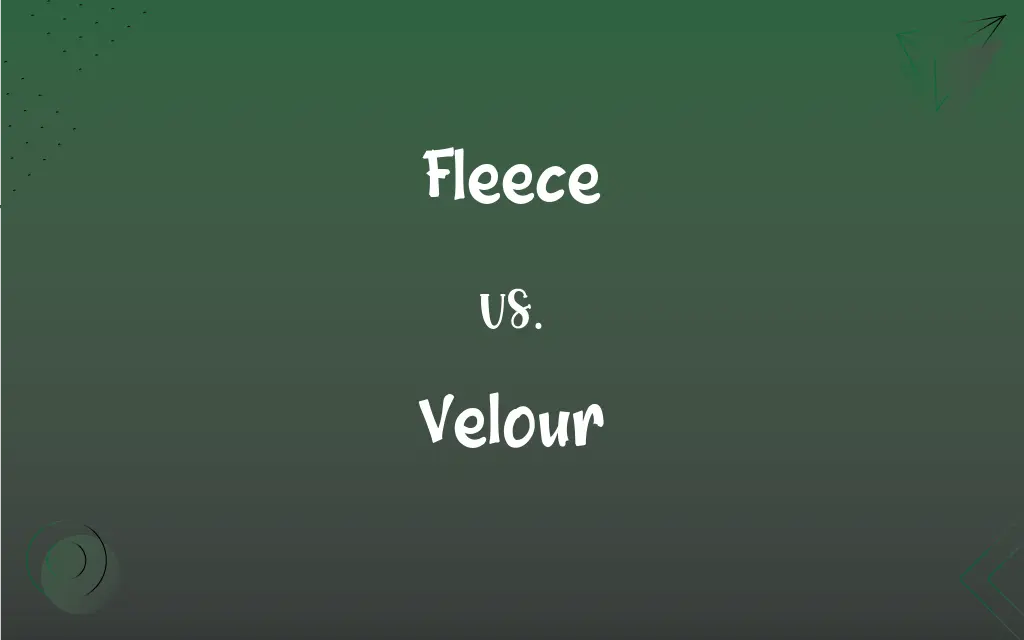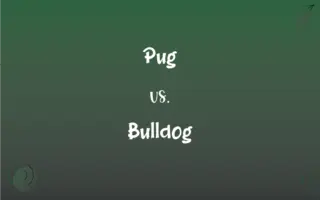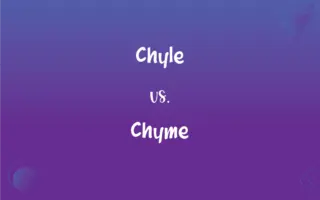Fleece vs. Velour: What's the Difference?
Edited by Harlon Moss || By Janet White || Updated on October 17, 2023
"Fleece" is a soft fabric made from polyester or wool used for warmth, while "Velour" is a plush, stretchy fabric, often knitted from cotton or polyester, resembling velvet.

Key Differences
Fleece is known for its ability to provide warmth, mimicking the properties of wool, making it perfect for cold weather clothing or blankets. In contrast, Velour boasts a luxurious texture and sheen, commonly used in upholstery, curtains, and casual wear due to its aesthetic appeal.
Synthetic Fleece is derived from polyester and has hydrophobic properties, repelling water and retaining insulation even when wet. However, Velour, with its closely-packed fibers and tufted weave, tends to absorb moisture, making it less suitable for wet conditions.
Fleece is lightweight and breathable, suitable for activewear and layering in transitional seasons. On the other hand, Velour is heavier with a drape characteristic, often preferred for fashion items and home decor for its rich, sumptuous look and feel.
Due to its manufacturing process, Fleece tends to pill after repeated use, which can affect its texture and appearance. Whereas, Velour requires careful maintenance to preserve its soft pile and lustrous surface, demanding more delicate handling and storage.
Fleece is often considered more casual and is commonly used in performance gear or everyday wear. In contrast, Velour is associated with luxury and elegance, making it a popular choice for loungewear, evening wear, and theatrical costumes.
ADVERTISEMENT
Comparison Chart
Material Composition
Typically polyester, sometimes wool or other synthetic blends
Often cotton or polyester, known for its velvet-like texture
Common Uses
Outerwear, sportswear, blankets
Luxury clothing, upholstery, curtains
Feel & Texture
Soft, fluffy, and warm
Plush, stretchy, and smooth
Care
Easy to care for, machine washable
Requires gentle handling, may need special cleaning
Moisture Management
Hydrophobic, dries quickly
Absorbs moisture, dries slower
ADVERTISEMENT
Fleece and Velour Definitions
Fleece
A fabric made from synthetic fibers, designed to mimic the feel of wool.
He wore his Fleece jacket on the hike to stay warm.
Velour
A plush, knitted fabric or textile similar to velvet.
The dancer's Velour outfit shimmered under the stage lights.
Fleece
The coat of wool covering a wool-bearing animal, such as a sheep.
The farmer sheared the Fleece from the sheep in early spring.
Velour
A fabric often made from cotton or polyester with a soft pile.
Her Velour dress was a hit at the holiday party.
Fleece
A lightweight, breathable fabric often used in active wear.
Her Fleece-lined leggings were perfect for the cool morning run.
Velour
A textile used in various accessories for its aesthetic appeal.
He chose a Velour hat to complete his stylish ensemble.
Fleece
The coat of wool of a sheep or similar animal.
Velour
A medium-weight fabric known for its stretchy and soft properties.
He bought a vintage Velour tracksuit from the thrift shop.
Fleece
The yield of wool shorn from a sheep at one time.
Velour
A material used in upholstery due to its luxurious texture.
The Velour sofa in the lobby was both elegant and inviting.
Fleece
A soft woolly covering or mass.
Velour
A closely napped fabric resembling velvet, used chiefly for clothing and upholstery.
Fleece
A soft, warm, lightweight, usually synthetic fabric with a deep pile, used primarily for clothing and blankets.
Velour
A felt resembling velvet, used in making hats.
Fleece
A garment, especially a shirt or jacket, made of such fabric.
Velour
A knit fabric similar to velvet, but usually somewhat coarser.
Fleece
To defraud of money or property; swindle.
Velour
Heavy fabric that resembles velvet
Fleece
To shear the fleece from.
Fleece
To cover with a fleece or similar covering.
Fleece
(uncountable) Hair or wool of a sheep or similar animal
Fleece
(uncountable) Insulating skin with the wool attached
Fleece
(countable) A textile similar to velvet, but with a longer pile that gives it a softness and a higher sheen.
Fleece
(countable) An insulating wooly jacket
Fleece
(roofing) Mat or felts composed of fibers, sometimes used as a membrane backer.
Fleece
Any soft woolly covering resembling a fleece.
Fleece
The fine web of cotton or wool removed by the doffing knife from the cylinder of a carding machine.
Fleece
(transitive) To con or trick (someone) out of money.
Fleece
(transitive) To shear the fleece from (a sheep or other animal).
During spring shearing we have to fleece all the sheep in just a few days.
Fleece
(transitive) To cover with, or as if with, wool.
Fleece
The entire coat of wool that covers a sheep or other similar animal; also, the quantity shorn from a sheep, or animal, at one time.
Who shore meLike a tame wether, all my precious fleece.
Fleece
Any soft woolly covering resembling a fleece.
Fleece
The fine web of cotton or wool removed by the doffing knife from the cylinder of a carding machine.
Fleece
To deprive of a fleece, or natural covering of wool.
Fleece
To strip of money or other property unjustly, especially by trickery or fraud; to bring to straits by oppressions and exactions.
Whilst pope and prince shared the wool betwixt them, the people were finely fleeced.
Fleece
To spread over as with wool.
Fleece
The wool of a sheep or similar animal
Fleece
Tanned skin of a sheep with the fleece left on; used for clothing
Fleece
A soft bulky fabric with deep pile; used chiefly for clothing
Fleece
Outer coat of especially sheep and yaks
Fleece
Rip off; ask an unreasonable price
Fleece
Shear the wool from;
Shear sheep
Fleece
A material known for its warmth and moisture-resistant properties.
The baby's Fleece blanket kept her cozy and dry.
Fleece
To deceive someone out of their money or possessions.
The con artist tried to Fleece the tourists with his fake merchandise.
FAQs
Is Velour a type of velvet?
Velour is a plush, knitted fabric that resembles velvet, but the two are distinct materials.
Is Velour similar to velvet?
Yes, Velour has a similar luxurious feel and appearance to velvet, but it's knitted, providing more stretch.
Does Fleece pill over time?
Yes, due to friction and wear, Fleece can pill, creating small balls of fiber on the surface.
Can Fleece be made from natural materials?
Traditionally, it's made from polyester, but eco-friendly versions can be made from recycled plastics or plant-based materials.
Can Fleece be recycled?
Yes, Polyester fleece can be recycled, and eco-fleece is often made from recycled materials.
What is Fleece commonly used for?
Fleece is frequently used for jackets, hats, sweaters, blankets, and performance attire due to its warmth and moisture-resistance.
Are there different types of Fleece?
Yes, there's microfleece, polar fleece, and others varying in thickness, breathability, and warmth.
Can Velour be used for furniture?
Yes, Velour is often used in upholstery for its plush texture and rich appearance.
Does Velour stretch easily?
Yes, Velour often contains elastic fibers, making it stretchy and comfortable to wear.
How does Fleece provide warmth?
Fleece traps a layer of air warmed by your body heat, providing insulation.
Is Fleece water-resistant?
Yes, Fleece has hydrophobic properties, meaning it repels water and dries quickly.
How should Velour be washed?
Velour should be washed inside out on a gentle cycle with cold water, and either air-dried or tumble-dried low.
What's the difference between crushed Velour and regular Velour?
Crushed Velour has a patterned appearance with irregular texture; regular Velour has a uniform, smooth surface.
Can Velour be ironed?
It's best to avoid direct ironing; use steam or an iron with a cloth barrier on a low heat setting.
Why is Fleece popular for outdoor activities?
Fleece is lightweight, breathable, and insulates even when wet, making it ideal for outdoor wear.
Does Fleece provide UV protection?
Some Fleece materials are treated to provide UV protection, but it's not inherent to all Fleece.
How is Fleece made?
Fleece is made by twisting and brushing polyester yarns to create a thick, warm texture.
Is Velour suitable for summer?
Typically, Velour is better suited for cooler temperatures due to its heavy, insulating nature.
How does Velour feel to the touch?
Velour is soft, smooth, and plush, similar to velvet but with a bit more stretch.
Is Velour an animal product?
No, Velour is a fabric typically made from cotton or synthetic fibers like polyester.
About Author
Written by
Janet WhiteJanet White has been an esteemed writer and blogger for Difference Wiki. Holding a Master's degree in Science and Medical Journalism from the prestigious Boston University, she has consistently demonstrated her expertise and passion for her field. When she's not immersed in her work, Janet relishes her time exercising, delving into a good book, and cherishing moments with friends and family.
Edited by
Harlon MossHarlon is a seasoned quality moderator and accomplished content writer for Difference Wiki. An alumnus of the prestigious University of California, he earned his degree in Computer Science. Leveraging his academic background, Harlon brings a meticulous and informed perspective to his work, ensuring content accuracy and excellence.































































